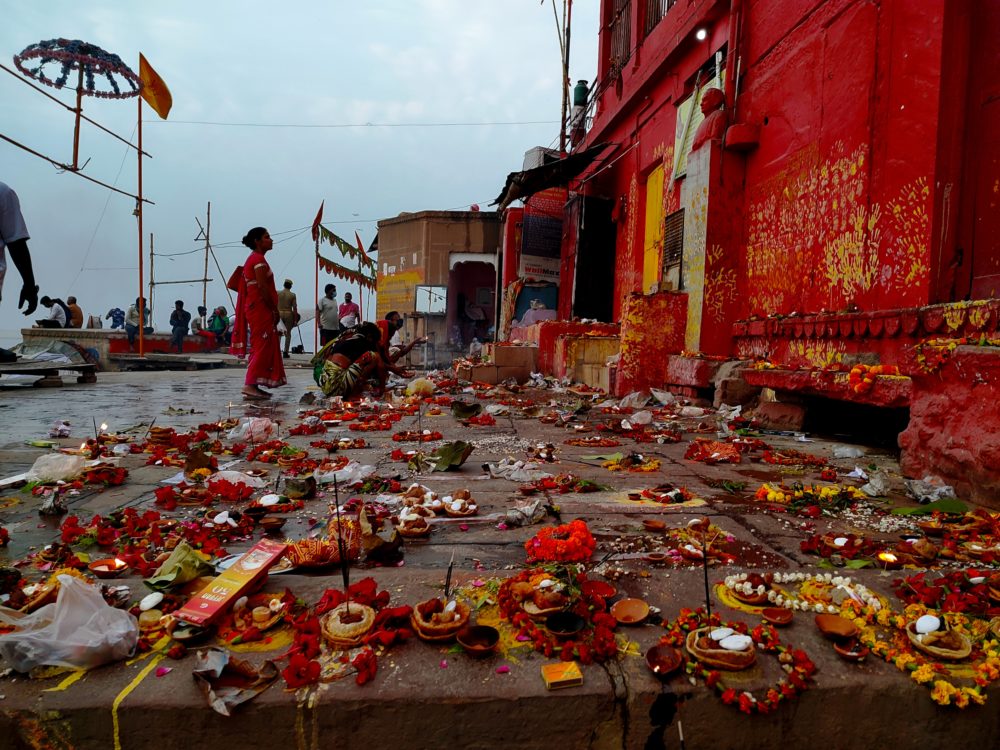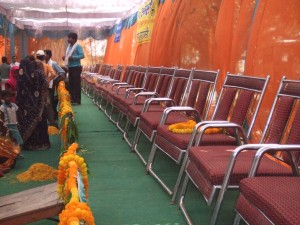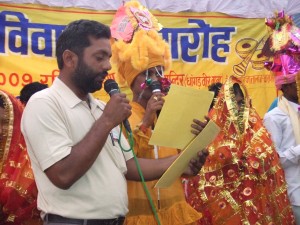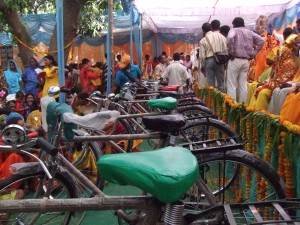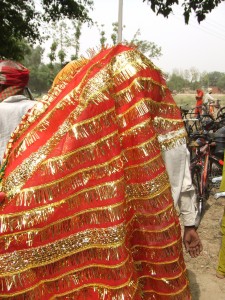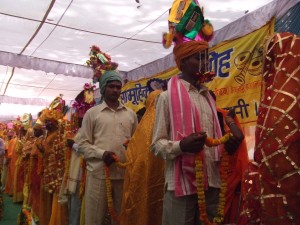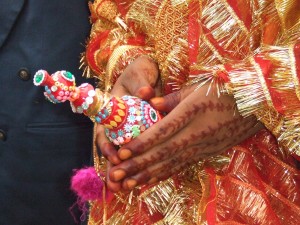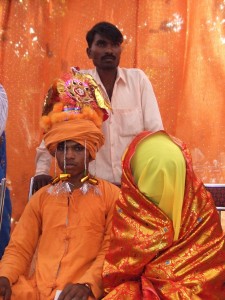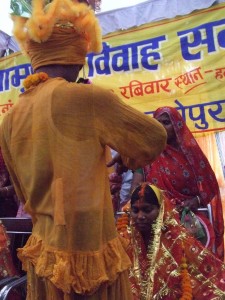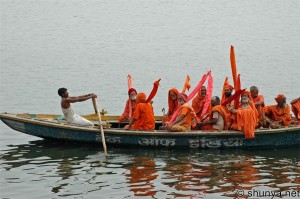
beautiful nature
I traveled to Nepal with my friend Babu to attend Kathmandu gay pride and it was a really unforgettable experience. I took a bus from Varanasi to Sonauli. There are several buses from Varanasi bus station and we took the last one at 8.30 pm. It was an overnight journey from Varanasi to Sonauli and the bus ride was really uncomfortable. The road was terribly bad and I just could not sleep for the whole night. Finally we arrived Sonauli border at 7 am and took a paddle rickshaw to cross the border. I was carrying a few electronics like video camera, photo camera and voice recorder etc. and wanted to declare them at the Indian custom office.
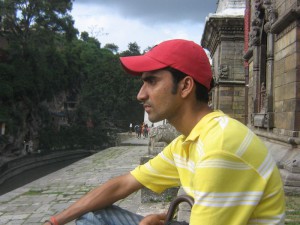
Babu at Pashupati nath temple
When I told Babu to about declaring the electronics at Indian custom office, he laughed at me and said that there was no need to do such thing but I had already experienced the problem before when I went to Nepal first time in 1996. Actually I was traveling to Nepal with my family those days. We had a camera and we informed the custom office at Sonauli border about this camera and got a receipt but we lost it somewhere in Nepal and returning time they checked our baggage and found that camera and said that it was not allowed to bring any electronics from Nepal to India.
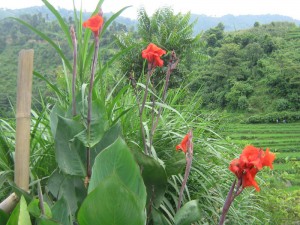
very colorful country
We were shocked and we told them that it was our camera which we had brought from India and we had a receipt but we lost it but those crazy custom officers said that it was not allowed. Actually they wanted a bribe so finally we gave them some money and only then we could move. I still had that story in my mind hence I did not want to take any risk. So I went to the custom office at Sounali border and told them that I had a few electronic goods and I wanted to declare them but as I told this, all those officers laughed and said: you are very smart.
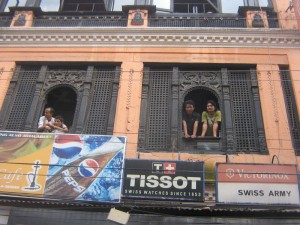
carving on Nepali houses
Anyways, I declared my stuffs and got a receipt for it but they again asked for a bribe only for giving me this receipt. I was like why bribe now? He said that this is system and I have to give them some money otherwise they would not give me my receipt. I gave him Rs. 20 but he said that he wanted at least Rs. 50. Finally I gave him Rs. 40 and took my receipt. I wast thinking that I declared my electronics in advance to avoid any kind of problem and corruption but there was actually no way to avoid it. After taking the receipt, we crossed the border and arrived Nepal.
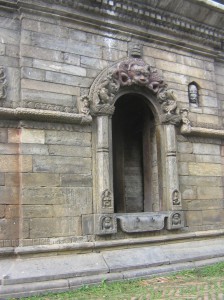
carvings on temples
Although Nepal also used to be a Hindu country only until a few years a go and I was hoping for Nepal culture to be close to Indian culture but Nepal was different starting from right at the border. Different looking people, different clothing, more working woman, different vehicles… there was a huge difference between India and Nepal. I really felt like being in another country. But there was something very similar to India- touts fucking tourists all the time. It was really overwhelming. Several people approached us right at the border to sell bus tickets to Kathmandu. They all wanted to sell bus tickets to Kathmandu and hotel rooms.
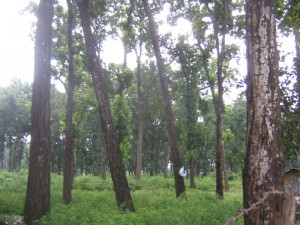
forest
Babu said that they were all touts and tell lies all the time. All of the touts were saying there was a bus going to leave within one hour but Babu said that these buses never leave before 4 pm. I did not believe Babu but my rickshaw driver also told me the same thing. Actually there are direct buses from Sonauli border to Kathmandu but only in early morning and late afternoon time like around 6-7 am or 4-5 pm. I was lucky that Babu was with me and I did not go with them. We took a bus from Sonauli border to a place called Bhairava which was hardly 30 minutes bus ride.
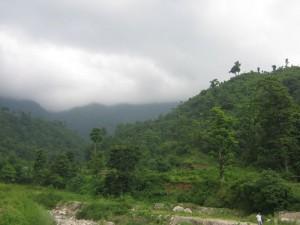
green and wet
Bhairava is the biggest bus station near Sonauli border and they have regular buses to Kathmandu. We arrived there by 9 o’clock and came to know that there was a bus a 9.30. I realized something really strange that Nepal has no government bus service; all the buses are private hence there is no fix fare or anything. I did not know that I was supposed to bargain even for bus fare but Babu managed it. There was a counter at the bus station and they asked us for Rs. 450 NR but ended up paying Rs. 350 NR.
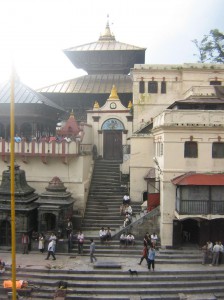
pashupati nath temple
The bus started at 9.30 but was stopped again right after 15 minutes by The army. I thought that he would check everyone but he just came in, looked around and started checking the bags of a few people. The strange thing about this check up was that they were not looking for arms only but they were looking for potatoes and sugar also. I started laughing when Babu told me that he was looking for potatoes and sugar but it was true. Actually the rate of sugar and potatoes and and other vegetables are different between India and Nepal hence they do not want people to smuggle cheap stuffs from India and sell them in Nepal. It was interesting.
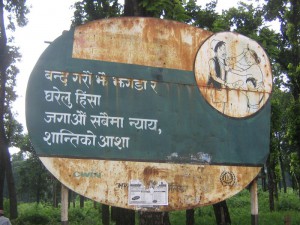
family voilence
Nepali buses were really crap. They were too small and had no space for my legs. It was raining continuously all the way from Sonauli border until Kathmandu and believe me the water was coming through the window even after closing it. I was wet all the time continuously for more than 12 hours in the bus. The nature was just awesome; clean river, fresh air, greenery… I noticed something really different in Nepal. I saw that there were more working women in Nepal than India. I notice that most of the shops were run by women and Nepali women seemed to be in better condition than Indian women.
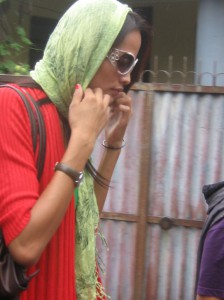
Nepali girl
Nepal seemed to be more progressive in terms of women rights when compered with India. The women were traveling alone, going to office, running shops, women auto rickshaw drivers and the women seemed more friendly with men… it looked really cool to me. I was happy to see it. I saw so many alcohol shops run by alone women. I had never ever seen anything like that anywhere in whole India. Once I saw an alcohol shop with a woman owner and I decided to talk with her. I went there and started asking about alcohol first and when we became friendly I asked her about her life.

liberal Nepali girl
I asked her if she feels safe sitting alone at alcohol shops and dealing with male customers who are drunk sometimes and she told me that she managing the business is just like any other male member of her family managing the business; no difference so problem to her. I asked her if people in the society mind women working at the alcohol shops and again she said that Nepali society is very progressive when it comes to equal rights for women. I asked her if she had ever been to India and she said that she had never been to India before but had seen India on TV. In reality she did not seem excited about visiting India.

the most beautiful alcohol bottle I had ever seen
I told her that it is just not possible to see any women selling alcohol in India and that there are less percentage of working women in India and she said that she was very well aware of the situation of women in India. She said that there are so many Indian families living in Nepal and they also do not allow their women to go out and work. I asked her what Nepali people think of this situation and she said that to be honest, we think that Indians are crazy and backward people. I was surprised to hear this but in reality yes, we are much backward than Nepal in terms of women rights and equal rights for women.
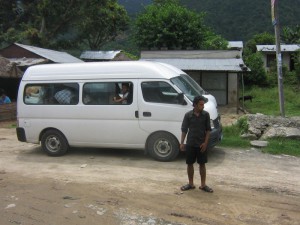
the most luxry way to travel in Nepal
The nature was just awesome all over Nepal. One could easily see that their nature is still untouched. Beautiful thick jungle, beautiful rivers, less industries, less people, less traffic and lots of mountains… it was just awesome. I really enjoyed nature a lot in Nepal. I also noticed that I saw only five big factories in my whole bus ride all the way from Sonauli till Kathmandu. In fact, two of them were Indian factories which sounds nice because there is less pollution because of less factories but there is another truth that there are less jobs because of less industries which means more poverty.
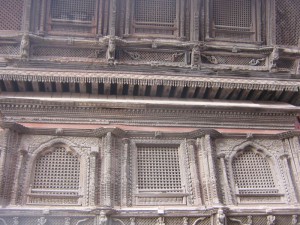
beautiful windows
Poverty in Nepal really hurt me. There were so many family houses right along the Sonauli-Kathmandu highways so I got to see so many people doing things. But the really interesting thing for me was that nobody was doing anything, just sitting or talking with people, that’s all. It seemed like they just don’t have any work. I had never seen that many young people just sitting here and there and passing time. There were so many kids selling water bottles and snacks on the road. Nepal has been suffering a lot from its political instability for the past few years which seems to be the biggest reason of poverty of Nepal. I dont know, maybe some other reason but Nepalis were just not happy at all from their political system.
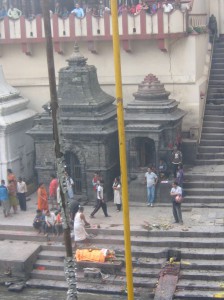
cremation at Pashupatinath temple
Finally we arrived Kathmandu by 8 PM and it was still raining. I had read about a neighborhood called Thamel which was full of hotel. I wanted to stay there. I asked Babu to ask some locals about where was this neighborhood and he told me that Nepali people are crazy and never tell you the right direction. He suggested me to go to any shop run by any Indian and ask them about the direction of Thamel. We went to a paan shop, bought a few things and asked him the direction to Thamel and fortunately he was a nice guy who told us the right direction to Thamel. It took us about 10 minutes of walk and we had to ask a few other people also the direction to Thamel but we arrived there.
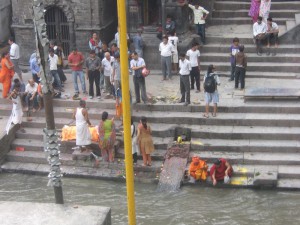
life and death at same place
We arrived Thamel which was full of hotels, in fact it was the most popular neighborhood in Nepal for backpackers. We went to several hotels but their price seemed too steep to us. Babu was telling me that we could easily find a hotel room worth 500 NR but none of them wanted to charge us less than 1000 NR. Finally we reached a hotel Annpurna hotel. They wanted to charge us 800 NR per night. I told him that I was a government approved tour guide in India and all the hotels give me discount in India then he agreed to give me a room for 500 NR.
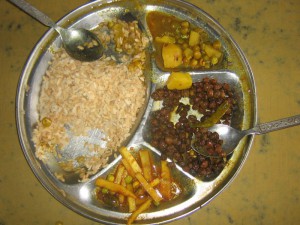
Nepali food that I didn't like at all
The hotel seemed nice at first but later we realized that pillow covers and bed sheets were used, cable connection was not working properly, telephone was there but dead. We complained about it and were promised to get everything on work by next morning but in fact this next morning never came before we left. In any case, I was not there to enjoy luxury, watch TV or make phone calls from my room hence I also did not mind it. We went out to take our dinner at some restaurant but most of the shops were closed by 8.30 PM. We found a restaurant opened and had our dinner there.

Nepali highways
I had read several articles about nightlife in Nepal including dance bars and massage centers. A lot of the articles said that Nepal nightlife was safe but most of them said that it was really crazy and dangerous. I had several articles talking about how people went to a night club, spent a few hours, had a few beers and dinner and paid Rs. 40-50,000 and were misbehaved. Several articles talked about how 14-15 years old kids are involved in sex industry and work as pimps. I was curious about what was going on and we had decided to visit at least one night club while being in Kathmandu.
I was just walking here and there in Thamel and saw so many massage parlors. Once we were just passing by a shop which had a sign board saying massage parlor and I was showing this to Babu. Suddenly a hardly 15 years old guy came to me and asked what I was looking at. I told him that I was just watching the advertisements and he said that no, I was looking for something else, something special. I was like no I was just looking here and there. He again asked me if I needed some special service and I told him that I did not need any special service.
We walked away from there but this guy was keep following us and was asking if we needed a girl. He offered us young beautiful girls for really cheap price. He was not alone, there were so many pimps here and there watching tourists. Anyways, I was able to get back to my hotel safely. The next day we worked for a while, walked around, did some shopping… and it was a nice experience. I really missed veg Indian food as it was meat everywhere. But I liked something that they had drinks very easily available so I was enjoying all different kinds of alcohol.
I wanted to use an ATM in Kathmandu but was concerned about paying international transaction fee but Babu told me that a few Indian banks also have their own ATMs in Kathmandu like State Bank of India and Punjab National Bank. There was one State Bank of India ATM near Darbar Square. I used this bank and did not pay any transaction fee. So I would suggest anyone holding Indian bank card should just look for Indian bank ATMs in Kathmandu. Telephones were also so cheap in Nepal. I paid only Rs. 1 per minute for a phone call to India.
Since we were so interested in visiting a night club in Kathmandu. we were gathering information about it through online sources. But fortunately I met a guy at the NGO, where I was supposed to work, who was a male prostitute. I thought who could provide better information than him about night life in Kathmandu. I asked him about it and he suggested me not to visit any night clubs in Kathmandu as they are not safe at all, especially for tourists. He also told me the same thing what I had read online so finally we decided that we would not visit any night club in Kathmandu.
We visited a few temples, markets and participated in Kathmandu Gay Pride. Finally my time was over in Kathmandu and now we needed to head back to home. Babu told me that they had overnight buses from Kathmandu to Sonauli until 10 PM. We arrived at the bus station around 8 PM but all the buses were already gone by then. They said that the last bus was at 7 PM. So we took our dinner, stayed at a hotel near bus station and took an early morning bus to Sounauli and then another bus from Sonauli to Varanasi. It was a successful journey full of learning. I really plan to go back again to Kathmandu sometime for longer period of time.
Please click here to see more pictures:
